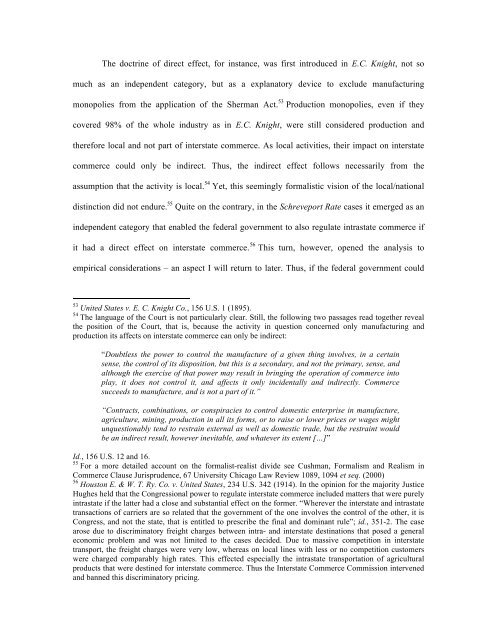Jasper Finke, Crisis and Law - New York University School of Law
Jasper Finke, Crisis and Law - New York University School of Law
Jasper Finke, Crisis and Law - New York University School of Law
You also want an ePaper? Increase the reach of your titles
YUMPU automatically turns print PDFs into web optimized ePapers that Google loves.
The doctrine <strong>of</strong> direct effect, for instance, was first introduced in E.C. Knight, not so<br />
much as an independent category, but as a explanatory device to exclude manufacturing<br />
monopolies from the application <strong>of</strong> the Sherman Act. 53 Production monopolies, even if they<br />
covered 98% <strong>of</strong> the whole industry as in E.C. Knight, were still considered production <strong>and</strong><br />
therefore local <strong>and</strong> not part <strong>of</strong> interstate commerce. As local activities, their impact on interstate<br />
commerce could only be indirect. Thus, the indirect effect follows necessarily from the<br />
assumption that the activity is local. 54 Yet, this seemingly formalistic vision <strong>of</strong> the local/national<br />
distinction did not endure. 55 Quite on the contrary, in the Schreveport Rate cases it emerged as an<br />
independent category that enabled the federal government to also regulate intrastate commerce if<br />
it had a direct effect on interstate commerce. 56 This turn, however, opened the analysis to<br />
empirical considerations – an aspect I will return to later. Thus, if the federal government could<br />
53 United States v. E. C. Knight Co., 156 U.S. 1 (1895).<br />
54 The language <strong>of</strong> the Court is not particularly clear. Still, the following two passages read together reveal<br />
the position <strong>of</strong> the Court, that is, because the activity in question concerned only manufacturing <strong>and</strong><br />
production its affects on interstate commerce can only be indirect:<br />
“Doubtless the power to control the manufacture <strong>of</strong> a given thing involves, in a certain<br />
sense, the control <strong>of</strong> its disposition, but this is a secondary, <strong>and</strong> not the primary, sense, <strong>and</strong><br />
although the exercise <strong>of</strong> that power may result in bringing the operation <strong>of</strong> commerce into<br />
play, it does not control it, <strong>and</strong> affects it only incidentally <strong>and</strong> indirectly. Commerce<br />
succeeds to manufacture, <strong>and</strong> is not a part <strong>of</strong> it.”<br />
“Contracts, combinations, or conspiracies to control domestic enterprise in manufacture,<br />
agriculture, mining, production in all its forms, or to raise or lower prices or wages might<br />
unquestionably tend to restrain external as well as domestic trade, but the restraint would<br />
be an indirect result, however inevitable, <strong>and</strong> whatever its extent […]”<br />
Id., 156 U.S. 12 <strong>and</strong> 16.<br />
55 For a more detailed account on the formalist-realist divide see Cushman, Formalism <strong>and</strong> Realism in<br />
Commerce Clause Jurisprudence, 67 <strong>University</strong> Chicago <strong>Law</strong> Review 1089, 1094 et seq. (2000)<br />
56 Houston E. & W. T. Ry. Co. v. United States, 234 U.S. 342 (1914). In the opinion for the majority Justice<br />
Hughes held that the Congressional power to regulate interstate commerce included matters that were purely<br />
intrastate if the latter had a close <strong>and</strong> substantial effect on the former. “Wherever the interstate <strong>and</strong> intrastate<br />
transactions <strong>of</strong> carriers are so related that the government <strong>of</strong> the one involves the control <strong>of</strong> the other, it is<br />
Congress, <strong>and</strong> not the state, that is entitled to prescribe the final <strong>and</strong> dominant rule”; id., 351-2. The case<br />
arose due to discriminatory freight charges between intra- <strong>and</strong> interstate destinations that posed a general<br />
economic problem <strong>and</strong> was not limited to the cases decided. Due to massive competition in interstate<br />
transport, the freight charges were very low, whereas on local lines with less or no competition customers<br />
were charged comparably high rates. This effected especially the intrastate transportation <strong>of</strong> agricultural<br />
products that were destined for interstate commerce. Thus the Interstate Commerce Commission intervened<br />
<strong>and</strong> banned this discriminatory pricing.
















